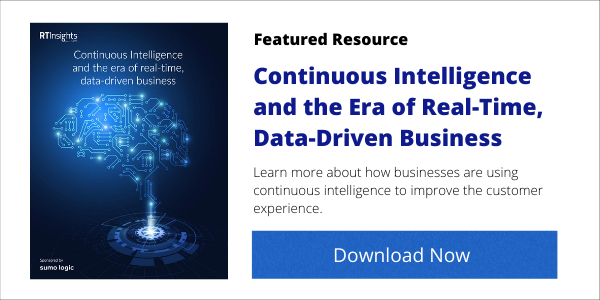
Enterprises have new opportunities to use emerging technology concepts like continuous intelligence to improve their customer experiences.
Great customer experience (CX) is a key talking point in CEO presentations across every industry. Often, they cite how they leverage customer data and advanced analytics for CX success. So, why are Yelp and Google customer reviews so often packed with comments like, “I’ll never do business with them again!”?
It’s CX gone wrong.
CX is an area of investment for enterprises that look beyond basic CRM analytics to real-time data analysis, phone “apps”, artificial intelligence and customer service bots. The goal: Keep happy customers buying more. Oh, and don’t forget that bots and telephone menu trees save on human resource costs.

CX service provider Survicate recently cited survey results hammering home the importance of a positive customer experience. It said 33% of consumers would consider changing companies immediately after getting poor service. Could it be that with so much technology in their portfolios enterprises still haven’t found the way to keep those customers happy? Worse, some are leaving customers angry and frustrated with issues like poor service, faulty products, and post-sale marketing spam.
The role of continuous intelligence
To see how companies can do CX better, consider some of the gaps commonly found in how they provide service. Then, think how real-time analytics might provide long-term benefits through continuous intelligence.
Consider one scenario.
A customer with a technical issue reaches a service representative on the help desk and quickly gets frustrated. It may be a case of the customer being unable to clearly describe their problem. Or, it could be an unsympathetic support rep. In fact, a dozen other factors can lead to stress and anger, which is reflected in the tone of the customer’s voice.
Machine learning technology today enables a help desk software system to recognize that stress and prompt the service rep to change their approach. In some cases, it will refer the customer to a senior rep. That’s progress when it comes to calming the situation, but it doesn’t get to the core problem: What led to the frustration?
Help desk management might retrain the rep, but the real problem may be poor product quality or usability. Poor quality is unlikely to impact just one customer; it’s likely cited in dozens of help desk tickets. That’s where the company brand and broader customer experience challenges comes into play. Things get out of hand unless product managers and marketing are alerted to what help desk callers are saying.
See Also: Continuous Intelligence Insights
AI and customer experience
Think how AI and machine learning can spot patterns in such customer service conversations not just for improving service rep performance. I also can alert product engineers to underlying issues that may not be reflected in the reps’ notes. Continuous intelligence is about systems – CX software or quality assurance – learning as business goes along, learning from hundreds of calls. The content of so many customers calls can help to shape product fixes and new generations of products.
When the product line is back in good shape, maybe the intelligence in the system can generate a “give us a second chance” email to those once-frustrated buyers. Tacking on a thank-you note from the CEO wouldn’t hurt.

Automation or humans
That brings up the debate about automation versus humans in customer-facing situations. Automation is a love-it-or-hate-it concept, but so is human involvement. As consumers needing help from time to time, we’ve probably cursed and praised both at various points.
For automation, it no longer seems to be a question of if enterprises will automate customer interaction – on the sales side as well as product support – but how the automation/human balance shapes up. Survicate addressed the topic of chatbots in its research, reporting that 63% of consumers were satisfied with their experiences with such chatbots. That survey was conducted in 2019, so it’s likely that there’s been ever more interaction with chatbots since the pandemic drove more business online. Yet, Survicate noted that even a satisfaction figure of 63% left more than a third of respondents less confident in the technology concept.
Plus, there was a caveat in what the consumers were asked. The question was about whether they were satisfied with chatbots, “assuming they can request a human customer service rep if needed”. You know the deal; “press 0 to be connected to a real person”.
“Humans are still crucial to the service aspect of digital CX, at this point in time. They should still be used in combination with chatbots to provide the best customer experience possible,” said the report.
Future of customer experience
That raises the possibility of new approaches to CX. If the customer experience involves both humans and bots, companies have an opportunity to learn from both. They can look for ways to apply common metrics, algorithms, and data collection methods to both support models.
If customers are dissatisfied or frustrated with automated systems, machine learning and continuous intelligence could provide the same type of insight into their challenges as today’s help desk software can. Satisfaction surveys may help in both models, but they only tell part of the story. The real meat is in understanding the customer’s full experience. Companies need to know factors such as how the customer accessed help systems, whether emotional outbursts were involved, how many service reps or bot interactions customers dealt with, how many company web pages they slogged through.
Know who I am
Whether customers are dealing with automated support systems or a call center, research also shows that they want personalized service.
“Consumers want hyper-personalized experiences more than ever, and big data analytics provides the findings to make this possible. According to Accenture, 75% of consumers are more likely to purchase from a company that knows their name, their purchase history, and/or recommends items based on their purchase history,” said Survicate.
That means understanding the customer’s situation. It’s unlikely that a customer struggling to get their computer or air conditioner working properly wants to be upsold by the same company. That would be inappropriate at a time when they are dealing with technicians, whether on the phone, in a chat, or in person. Also, they don’t want to have to repeat their name, account number, and problem to three different tech support reps on a single call.
CX is an area where continuous intelligence can start to deliver even the most basic benefits to an organization and its customers. It collects and analyzes relevant information in the form of historical and real-time data about the customer, their product, and the issues that other customers have encountered over time. In the end, that’s intelligence.
Featured Resource: Continuous Intelligence and the Era of Real-Time, Data-Driven Business [Download Now]






